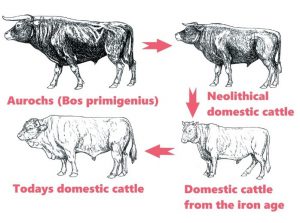A crucial part of human history is the development of taming animals to help in daily life, rather than as prey to be hunted or a predator to be avoided. While the topic is not heavily focused on, domestication of animals was just as important as the domestication and farming of plants, because the animals were needed to be able to work the land and were a more reliable source of food than the harvest that may not come.

An estimated timeline of animal domestication
Saey, Tina Hesman. “DNA Evidence Is Rewriting Domestication Origin Stories.” Science News, Science News, 2 Aug. 2018, www.sciencenews.org/article/dna-evidence-rewriting-domestication-origin-stories
Domestication happened at different points in all corners of the world, but animals were all domesticated for a reason, even if that is not their purpose now. Dogs were domesticated to assist in hunting, oxen to pull heavy loads, and farm animals like cows, horses, goats, and sheep for food and milk. While some roles are the same, dogs are no longer primarily used for hunting, horses developed into a means of transportation, and goats have recently been used to eat unwanted plants! Why wasn’t every animal domesticated? The animals that were domesticated usually had flexible diets that didn’t require much work on the human’s part, manageable temperaments, changeable social hierarchy, and would be easily bred in captivity. For example, it wouldn’t be very helpful to domesticate meerkats who have a strict social hierarchy and a specific diet along with a lack of purpose under human control.

The evolution of cattle domestication
“Domesticated Animals.” Archäologisches Freilichtmuseum Oerlinghausen, Archaeological Open-Air Museum Oerlinghausen, afm-oerlinghausen.de/en/afm-rundgang-en/steinzeit-en/jungsteinzeit-en/haustiere-en#prettyPhoto.
Domesticating a species involves human interference in the animals’ breeding patterns. Dogs were domesticated from wolves by selecting the wolf pups that were likely the least aggressive, most obedient, had smaller jaws, or a certain coloring depending on the culture that was domesticating them. This select breading has created the entirely new species of dog, separate from wolf. Domestication also affects the animals brought into human life. Archeologists can usually tell if certain animals are domesticated based on their bones Domesticated horses and cattle used to pull heavily loads for farm work often have osteoarthritis or leg strain that would not be there otherwise.
Animal domestication changed a great deal of human society. It allowed for more permanent settlement as cattle provided a reliable food and supply source. With settlement and supplies came population growth and density and a development of communities that worked to provide everything needed for the people around, even if they weren’t of direct relation as was the previous custom. A downside to domestication was the spread of diseases between humans and animals that would have otherwise jumped between species. Pig flu and transfer of parasites are just a few examples of humans and animals getting a little too close. But without domestication humans may well still be wandering hunter-gatherers.
Further Reading:
History of the Domestication of Animals
http://www.historyworld.net/wrldhis/PlainTextHistories.asp?historyid=ab57
Domestication
https://www.britannica.com/science/domestication
References:
Bahn, Paul and Colin Renfrew 2010 Archaeology Essentials. 2nd Edition Thames & Hudson —–x—-Inc., New York, NY.
“Domesticated Animals.” Archäologisches Freilichtmuseum Oerlinghausen, Archaeological Open-Air Museum Oerlinghausen, afm-oerlinghausen.de/en/afm-rundgang-en/steinzeit-en/jungsteinzeit-en/haustiere-en#prettyPhoto.
Lear, Jessica. “Our Furry Friends: the History of Animal Domestication.” Journal of Young Investigators, 17 Feb. 2012, www.jyi.org/2012-february/2017/9/17/our-furry-friends-the-history-of-animal-domestication.
National Geographic Society. “Domestication.” National Geographic Society, 9 Oct. 2012, www.nationalgeographic.org/encyclopedia/domestication/.
Saey, Tina Hesman. “DNA Evidence Is Rewriting Domestication Origin Stories.” Science News, Science News, 2 Aug. 2018, www.sciencenews.org/article/dna-evidence-rewriting-domestication-origin-stories

Where were things first domesticated, and how do you think that has effected certain elements of that places history? You say things happened at different places and times, but did domestication in Europe effect, for example, resistance to diseases that ended up killing a majority of Native Americans?
Animals were domesticated all over the world at different times. In fact, some animals were domesticated “twice”, such as the dog, domesticated in Europe and East Asia separately during different time periods(Curley 2016). It can be hard to pinpoint exact domestication dates, because the way to determine if an animal was domesticated is by examining skeletal remains and comparing remains of known wild species to known domesticated species. The study of domestication is advancing and finding answers to our many questions.
It is known that domestication of animals had a greater effect in Europe and Asia than the Americas due to the animals native to those parts of the world. For example, Europe had goats, sheep, and cattle that could be domesticated and allow for more permanent settlements with a reliable food source. Therefore, we see Europe develop large towns and cities while the Americas had less by comparison. In the Americas they did not have goats, sheep, and cattle until the Europeans came, so they could not domesticate them and develop long term settlements (Crosby 2001). This is why we see more nomadic habits in the Americas pre-colonialism. They needed to move with their food, so permanent settlements were not an option. This is a prime example of cultural differences, as one way of life was not better than another, each group was just utilizing the resources at their disposal.
Crosby, Alfred W
2001 The Columbian Exchange: Plants, Animals, and Disease between the Old and New Worlds. National Humanities Center
Curley, Robert and John P. Rafferty
2016 Domestication. Encyclopaedia Britannica